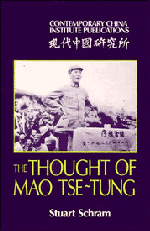Part 1 - Mao Tse-tung's thought to 1949
Published online by Cambridge University Press: 23 December 2009
Summary
Mao Tse-tung's thought, as it had found expression prior to the establishment of the Chinese People's Republic, was at once the synthesis of his experience down to 1949, and the matrix out of which many of his later policies were to grow. Part I seeks to document and interpret the development of Mao's thought during the first three decades of his active political life. It also tries to prepare the reader better to understand what came after the conquest of power. While stressing those concerns which were uppermost in Mao's own mind in the earlier years, it also devotes attention to ideas of which the implications were fully spelled out only in the 1950s and 1960s.
As regards the context in which Mao's ideas evolved, the period from 1912 (when Mao, at the age of 18½, returned to his studies after half a year as a soldier in the revolutionary army) to 1949 (when he became the titular and effective ruler of a united China) was one of ceaseless and far-reaching political, social and cultural change. Mao lived, in effect, through several distinct eras in the history of his country during the first half-century of his life, and the experience which shaped his perception of China's problems, and his ideas of what to do about them, therefore varied radically not only from decade to decade, but in many cases from year to year.
- Type
- Chapter
- Information
- The Thought of Mao Tse-Tung , pp. 13 - 94Publisher: Cambridge University PressPrint publication year: 1989
- 1
- Cited by



